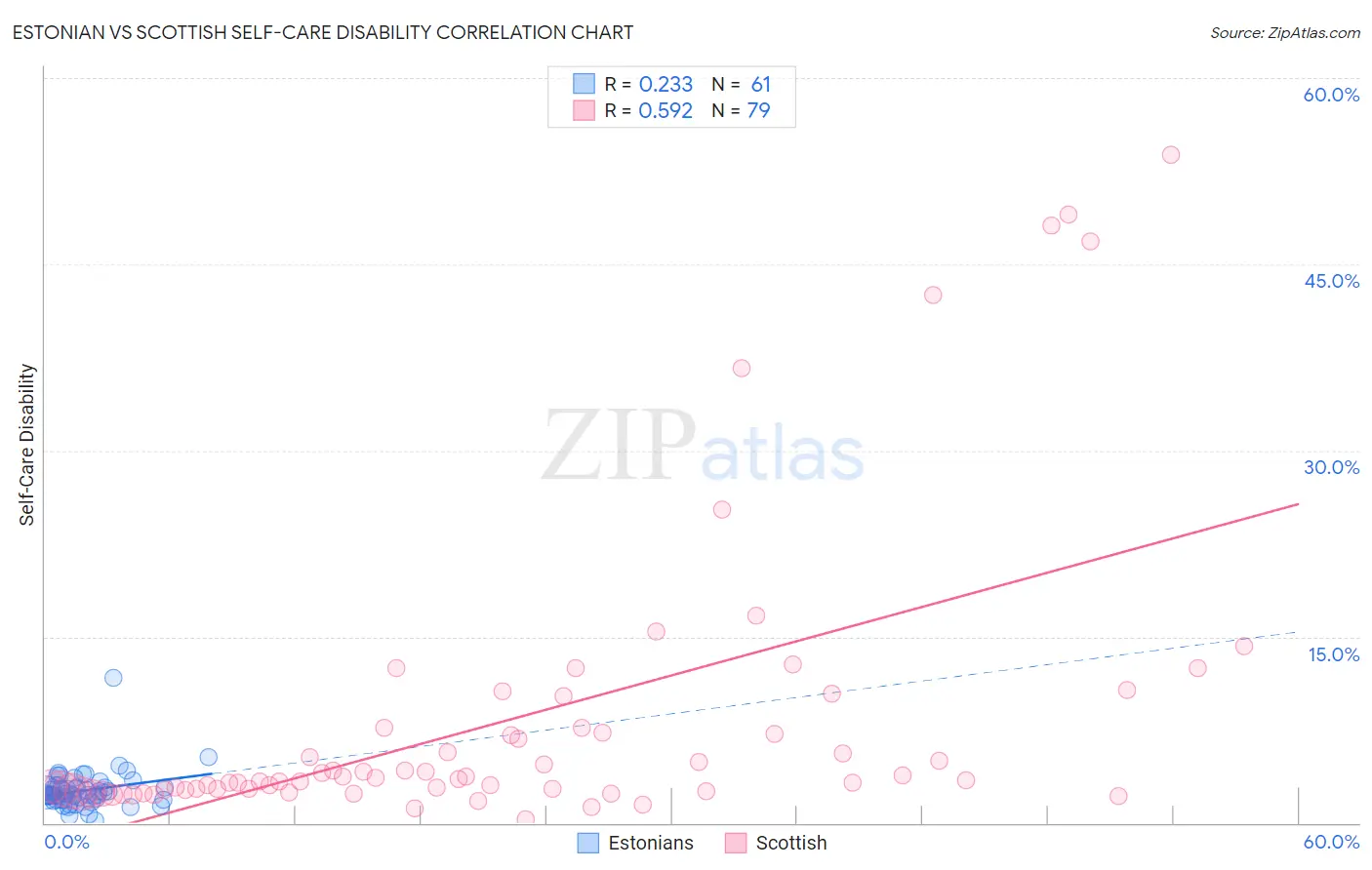Estonian vs Scottish Self-Care Disability
COMPARE
Estonian
Scottish
Self-Care Disability
Self-Care Disability Comparison
Estonians
Scottish
2.3%
SELF-CARE DISABILITY
98.3/ 100
METRIC RATING
85th/ 347
METRIC RANK
2.5%
SELF-CARE DISABILITY
54.3/ 100
METRIC RATING
170th/ 347
METRIC RANK
Estonian vs Scottish Self-Care Disability Correlation Chart
The statistical analysis conducted on geographies consisting of 123,478,369 people shows a weak positive correlation between the proportion of Estonians and percentage of population with self-care disability in the United States with a correlation coefficient (R) of 0.233 and weighted average of 2.3%. Similarly, the statistical analysis conducted on geographies consisting of 564,803,719 people shows a substantial positive correlation between the proportion of Scottish and percentage of population with self-care disability in the United States with a correlation coefficient (R) of 0.592 and weighted average of 2.5%, a difference of 4.8%.

Self-Care Disability Correlation Summary
| Measurement | Estonian | Scottish |
| Minimum | 0.24% | 0.29% |
| Maximum | 11.7% | 53.8% |
| Range | 11.4% | 53.6% |
| Mean | 2.6% | 8.3% |
| Median | 2.3% | 3.6% |
| Interquartile 25% (IQ1) | 1.9% | 2.6% |
| Interquartile 75% (IQ3) | 2.9% | 7.7% |
| Interquartile Range (IQR) | 0.99% | 5.0% |
| Standard Deviation (Sample) | 1.5% | 11.8% |
| Standard Deviation (Population) | 1.5% | 11.7% |
Similar Demographics by Self-Care Disability
Demographics Similar to Estonians by Self-Care Disability
In terms of self-care disability, the demographic groups most similar to Estonians are Immigrants from Northern Africa (2.3%, a difference of 0.020%), Sierra Leonean (2.4%, a difference of 0.16%), Lithuanian (2.4%, a difference of 0.16%), Immigrants from Congo (2.4%, a difference of 0.21%), and Immigrants from Spain (2.3%, a difference of 0.34%).
| Demographics | Rating | Rank | Self-Care Disability |
| Immigrants | Ireland | 99.0 /100 | #78 | Exceptional 2.3% |
| Immigrants | Kenya | 99.0 /100 | #79 | Exceptional 2.3% |
| Chileans | 98.8 /100 | #80 | Exceptional 2.3% |
| Ugandans | 98.8 /100 | #81 | Exceptional 2.3% |
| Immigrants | Denmark | 98.8 /100 | #82 | Exceptional 2.3% |
| Indians (Asian) | 98.7 /100 | #83 | Exceptional 2.3% |
| Immigrants | Spain | 98.7 /100 | #84 | Exceptional 2.3% |
| Estonians | 98.3 /100 | #85 | Exceptional 2.3% |
| Immigrants | Northern Africa | 98.2 /100 | #86 | Exceptional 2.3% |
| Sierra Leoneans | 98.0 /100 | #87 | Exceptional 2.4% |
| Lithuanians | 98.0 /100 | #88 | Exceptional 2.4% |
| Immigrants | Congo | 98.0 /100 | #89 | Exceptional 2.4% |
| Immigrants | Czechoslovakia | 97.7 /100 | #90 | Exceptional 2.4% |
| Immigrants | Jordan | 97.7 /100 | #91 | Exceptional 2.4% |
| Icelanders | 97.4 /100 | #92 | Exceptional 2.4% |
Demographics Similar to Scottish by Self-Care Disability
In terms of self-care disability, the demographic groups most similar to Scottish are Pennsylvania German (2.5%, a difference of 0.030%), Czechoslovakian (2.5%, a difference of 0.040%), Immigrants from Burma/Myanmar (2.5%, a difference of 0.070%), Immigrants from Somalia (2.5%, a difference of 0.080%), and Ute (2.5%, a difference of 0.14%).
| Demographics | Rating | Rank | Self-Care Disability |
| German Russians | 62.7 /100 | #163 | Good 2.5% |
| Immigrants | Vietnam | 59.3 /100 | #164 | Average 2.5% |
| Syrians | 59.0 /100 | #165 | Average 2.5% |
| Canadians | 58.8 /100 | #166 | Average 2.5% |
| Immigrants | Greece | 57.3 /100 | #167 | Average 2.5% |
| Ute | 57.1 /100 | #168 | Average 2.5% |
| Immigrants | Somalia | 55.9 /100 | #169 | Average 2.5% |
| Scottish | 54.3 /100 | #170 | Average 2.5% |
| Pennsylvania Germans | 53.5 /100 | #171 | Average 2.5% |
| Czechoslovakians | 53.5 /100 | #172 | Average 2.5% |
| Immigrants | Burma/Myanmar | 52.8 /100 | #173 | Average 2.5% |
| Welsh | 50.0 /100 | #174 | Average 2.5% |
| Immigrants | Bosnia and Herzegovina | 49.6 /100 | #175 | Average 2.5% |
| Immigrants | Afghanistan | 47.6 /100 | #176 | Average 2.5% |
| Immigrants | Kazakhstan | 46.7 /100 | #177 | Average 2.5% |